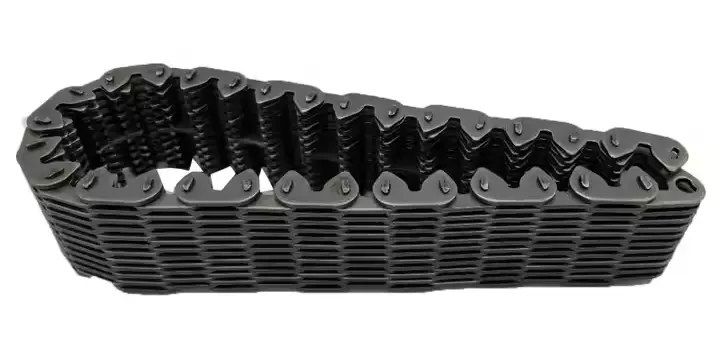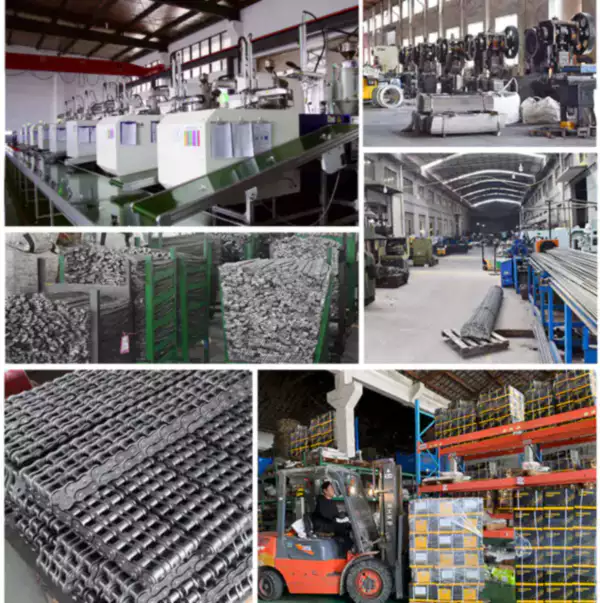Introduction
Inverted tooth timing chains are a popular choice for various high-performance applications, including automotive engines, motorcycles, and heavy-duty machinery. They offer several benefits over conventional timing chains, including reduced noise, improved efficiency, and higher durability. However, under extreme operating conditions, such as high temperatures, high loads, or high speeds, the performance of inverted tooth timing chains can be affected. In this article, we will explore the performance of inverted tooth timing chains under such conditions and how they compare to other types of timing chains.
What are Inverted Tooth Timing Chains?
Inverted tooth timing chains, also known as silent chains, are a type of chain drive that uses a toothed link design to reduce noise and vibration. The links consist of a pin and two asymmetrical plates with teeth on one side. The teeth mesh with the sprockets, creating a positive engagement that allows for accurate and smooth power transmission. The asymmetrical design of the plates and pins provides a self-aligning and self-tensioning effect that reduces wear and fatigue.
Advantages of Inverted Tooth Timing Chains
The benefits of inverted tooth timing chains include:
- Reduced noise and vibration: The toothed link design and positive engagement reduce the rattling and slapping noise common in conventional timing chains.
- Improved efficiency: The positive engagement and self-aligning effect reduce the friction and wear, improving the overall efficiency of the chain drive.
- Higher durability: The self-tensioning effect and reduced wear and fatigue increase the service life of the chain, reducing maintenance costs and downtime.
Performance Under Extreme Conditions
Inverted tooth timing chains have been tested under various extreme conditions, such as:
- High temperatures: Inverted tooth timing chains can withstand temperatures up to 300¡ãC, making them suitable for high-performance engines that generate a lot of heat.
- High loads: Inverted tooth timing chains can handle high loads, thanks to their self-tensioning and self-aligning effects that distribute the load evenly across the teeth and plates.
- High speeds: Inverted tooth timing chains can operate at high speeds, thanks to their positive engagement and reduced vibration that prevents the chain from skipping or jumping off the sprockets.
However, under extreme conditions, the performance of inverted tooth timing chains can be affected, leading to:
- Increased wear and fatigue: High temperatures, loads, or speeds can increase the wear and fatigue of the chain, reducing its service life.
- Reduced efficiency: High temperatures or loads can increase the friction and reduce the efficiency of the chain, leading to power losses and reduced performance.
- Increased noise and vibration: High speeds or loads can increase the noise and vibration of the chain, leading to rattling, slapping, or whining.
Therefore, it is important to choose the right type of inverted tooth timing chain for the specific application, taking into account the operating conditions and requirements.

Comparison with Other Types of Timing Chains
Inverted tooth timing chains have several advantages over other types of timing chains, including:
- Roller chains: Inverted tooth timing chains are quieter, more efficient, and more durable than roller chains, thanks to their toothed link design and positive engagement.
- Gear chains: Inverted tooth timing chains are lighter, more flexible, and easier to install than gear chains, thanks to their chain-like structure and self-aligning effect.
- Belt chains: Inverted tooth timing chains offer higher durability, precision, and flexibility than belt chains, thanks to their metal construction and toothed link design.
However, each type of timing chain has its own advantages and disadvantages, and the choice depends on the specific application and operating conditions.

Sprockets for Silent Chains
Silent chain sprockets are an essential part of the inverted tooth timing chain drive, as they provide the teeth that mesh with the chain links and transmit the power. The design and quality of the sprockets can affect the performance, efficiency, and durability of the chain drive, especially under extreme conditions. Therefore, it is important to choose the right type of silent chain sprocket for the specific application, taking into account the tooth profile, pitch, diameter, material, and surface finish.
At RP Techniek BV, we offer a wide range of silent chain sprockets that are designed and manufactured to the highest standards of quality and reliability. Our sprockets are made of high-grade materials, such as alloy steel, carbon steel, or stainless steel, and are heat-treated and surface-finished to ensure maximum performance and durability. We also offer custom-made sprockets that are tailored to the specific needs and requirements of our customers.

About Us
RP Techniek BV is the official sales agent of Ever-power Group in the Netherlands, offering a wide range of high-quality power transmission products, including chains, sprockets, gears, couplings, and belts. Our products are used in various industries, such as automotive, aerospace, mining, agriculture, and robotics. We are committed to providing our customers with competitive prices, fast delivery, and excellent service, backed by our experienced and knowledgeable team of engineers and technicians.

Q&A
Q: What is the maximum speed for inverted tooth timing chains?
A: The maximum speed for inverted tooth timing chains depends on several factors, such as the pitch, the tooth profile, the diameter, and the lubrication. Generally, inverted tooth timing chains can operate at speeds up to 20 m/s or 4000 rpm, but this may vary depending on the specific application and operating conditions.
Q: How do inverted tooth timing chains compare to other types of chains in terms of noise?
A: Inverted tooth timing chains are quieter than most types of chains, thanks to their toothed link design and positive engagement that reduce the rattling and slapping noise. However, some types of chains, such as silent chains or belt chains, may be even quieter, depending on the specific application and operating conditions.
Q: What is the typical service life of inverted tooth timing chains?
A: The typical service life of inverted tooth timing chains depends on several factors, such as the load, the speed, the temperature, the lubrication, and the maintenance. Generally, inverted tooth timing chains can last from 10,000 to 100,000 hours of operation, but this may vary depending on the specific application and operating conditions.
Q: Can inverted tooth timing chains be used in high-temperature applications?
A: Yes, inverted tooth timing chains can withstand temperatures up to 300¡ãC, making them suitable for high-temperature applications, such as turbocharged engines, exhaust systems, or industrial furnaces. However, the lubrication and maintenance must be adapted to the high temperature to avoid premature wear and failure.
Q: What is the main advantage of inverted tooth timing chains over conventional timing chains?
A: The main advantage of inverted tooth timing chains over conventional timing chains is their reduced noise and vibration, thanks to their toothed link design and positive engagement. This makes them especially suitable for high-performance engines and machinery that require smooth and quiet operation.
Edited by: Zqq.
